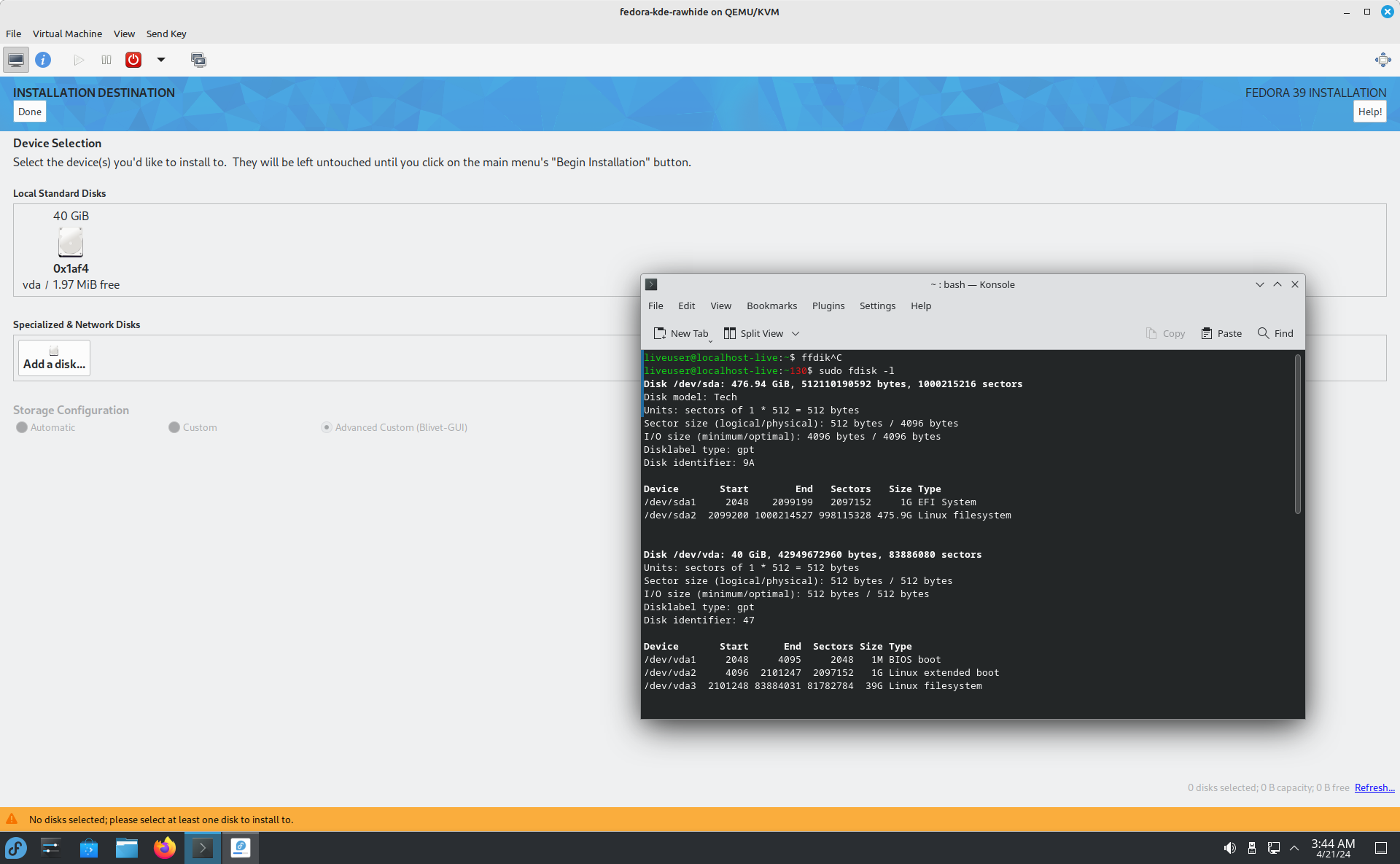Did you perform a full shutdown of Windows (Windows doesn’t fully release the partition on a normal shutdown)?
- 0 Posts
- 25 Comments
Edit: adding some context. I am planning to setup a dev machine that I will connect to remotely and would like to babysit very little while having stable and fresh packages. In the Ubuntu world we would go to an LTS release but on the RPM/Dnf world is there any other distro apart from CentOS Stream? And also is CentOS Stream comparable to an LTS release at all considering that they do not have release number?
Wanting both stable and fresh packages is unfortunately somewhat difficult in my experience. I think the primary choice within the Fedora ecosystem is if you want to have fresh packages (Fedora) or if you prefer a slower update cycle and more stable packages (RHEL/Alma/Rocky). In the second case you can also choose if you wish to pay Red Hat for support (RHEL) or not (Alma or Rocky).
One thing that’s quite different in RHEL vs Ubuntu/Debian ist that it gets minor releases that include substantial new features. For example you’ll get new compilers, python versions, drivers, … CentOS Stream gets those slightly ahead of RHEL/Alma/Rocky (a cynical person might say that CentOS Stream is a rolling beta for RHEL). But, IMHO that’s not really a strong reason to use CentOS Stream.
If you’d go with an Ubuntu LTS release, then I’d look into RHEL/Alma/Rocky.

 10·2 months ago
10·2 months agoThe driver should already be installed but there seems to be an issue with
brlttyregistering the corresponding USB ID when they shouldn’t. You can probably fix it by following this guide: https://koen.vervloesem.eu/blog/how-to-stop-brltty-from-claiming-your-usb-uart-interface-on-linux/ (or this one: https://unix.stackexchange.com/a/670637)Edit: Perhaps this has since been fixed in Mint 21 / Ubuntu 22.04.
You can make this work using ext and Timeshift rsync. I have also opted to exclude
/var/lib/flatpak/because it’s quite large. With that, my 5 snapshots currently take up about 34 GB.However, I would recommend backing up your deb applications/packages (typically installed under
/usr), as those can be critical for your system.
This “new law” was passed more than a year ago… But, it’s still a step in the right direction.

 1·4 months ago
1·4 months agoOne way to do it is have a small Python (or any other scripting language really) script that performs text replacements in the Latex source file. This is much easier in Latex because it’s plain text. I don’t know of a solution that doesn’t involve writing your own code (apart from LO/Word serial letters).

 7·4 months ago
7·4 months agoIs using Latex an option? I’ve done that and it works quite nicely. You can easily populate a template e.g. using Python.
That looks like a software issue… I would try a different distro or a different version of Ubuntu (e.g. 22.04).

 1·5 months ago
1·5 months agoThanks for trying it out on your own system!
In my case, the problem was that the disk never showed up in the Fedora installer. I’ve quickly reproduced the issue in a VM (but I originally noticed it on bare metal):

As you can see in fdisk, the disk (/dev/sda) has been recognized correctly by the kernel and works as expected. But somehow the installer only shows the “internal” /dev/vda.
After some further investigation, this seems to be related to the specific USB drives. I tried three different ones. It failed on a USB stick and the original external NVME enclosure. However, it did accept my USB to SATA adapter. So I guess I could install Fedora on my 10-year old HDD… 😐


 1·5 months ago
1·5 months agoDid you do anything special to install Fedora it on the USB drive? I couldn’t get it to do that and would be interested in testing F40 that way.

 2·5 months ago
2·5 months agoAh, that would put a bit of complication into things. If you want to actually accomplish this though, you should largely start with the same steps as a standard system install, using a second USB flash drive to write the distro onto the external SSD, leaving enough space to build the rest of the partitions you need.
I’ve actually tried to install Fedora on an USB SSD to play around with it. But somehow the installer just refused to select the second USB drive as an installation target. I looked for quite some time but couldn’t find a way to do it. I ended up trying to install it manually like Arch (for fun), but never got a bootable system 😅 I was able to install Arch and NixOS on the same drive without issue.
I’m actually not sure how OP could achieve something close to what they’re looking for… A regular installation certainly seems like the right choice, but that may require using an internal drive.
Yeah, NTFS being the problem actually makes a more sense.
OP could also just use the fuse driver then. I’m using it on 5.15 (Linux Mint) and it works quite well. I only had problems when I tried to use it for a Steam library.
You could also try to switch the kernel version. Ubuntu 22.04 currently supports two different versions: 5.15 and 6.5, you could switch to the other one and see if the problem also occurs there.
Ah nice, thanks for pointing me to it!
Makes sense.
No, I wish for something like Alma, but declarative and atomic :)
What do you miss in NixOS (Unstable)?
I think a declarative, atomic LTS distro (e.g. Alma) would be quite nice for business use.

 5·5 months ago
5·5 months agoThat looks quite weird… RHEL 9.2 was patched in February. RHEL 7 and RHEL 8 have now been patched too, but RHEL 9 (9.3) is still vulnerable?
Nah, it’s been upstream since RHEL locked down. Rocky’s been doing some funky stuff though.
AlmaLinux mostly ships packages that are maintained by Red Hat for RHEL, which is why I called it effectively a downstream. But maybe we can just agree that they’re related and it’s complicated 😅
Good thing there’s flatpak, snap, appimage, nix, guix, distrobox, etc. to keep you up to date. The question is then: do you mind if your DE and drivers don’t change for years. And that’s perfectly fine for a lot of people.
Yes, the situation has certainly improved, especially for GUI applications. But there’s always some trade-offs involved with those alternative packaging options. The nice thing is that you can freely choose if you want such a very-LTS option, or something fresher :)
AlmaLinux is effectively a downstream of RHEL, so it inherits a lot of RHEL’s pros and cons. I think, from a technical perspective, it makes a lot of sense for professional applications. It has a rock solid base OS that only changes rarely, which has lead to widespread support among professional (commercial) software. On top of that you get more regular updates to hardware support and (some) applications. You also get very long support times, which can make sense for some use cases.
On the hand, this model certainly also has its downsides. Towards the end of the life cycle, the packages get very old, especially the base OS (e.g. RHEL 7, which goes EOL this year, ships with gcc version 4.8). If you care about having the latest and greatest packages, this is not a distro for you. It’s also not clear if Red Hat will try to further crack down on their downstream distros…
Overall, I think it’s a good choice for a professional environment, where you don’t need bleeding edge packages. Some commercial software also doesn’t give you a lot of other options. For personal use, I’d probably look for another distro, unless you’re looking for a very slow update cycle.

I’ve also recently built my own NAS and I’ve gone through similar considerations. One of my mayor decisions was not to use btrfs because it’s not recommended for Raid Z1/Raid 5. With that, I landed on ZFS and TrueNAS Scale. Note that RAID expansion should be landing in both very soon.
Things with TrueNAS were pretty easy, very quick, and everything worked nicely. However, I noticed that it was constantly accessing the disks and preventing them from spinning down. I really wanted to keep the power consumption low (<20 W idle), so I eventually decided to just go with Vanilla Debian + ZFS. I can recommend that if you want to tinker with things yourself. Otherwise, I’d recommend TrueNAS Scale.
As for migration, you might be able to create a degraded pool initially, copy over the data, and add the parity disk last. Raid expansion would ofc also help there…